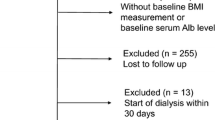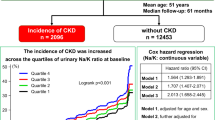Abstract
Background
This study aimed to determine the association between the urinary protein-to-creatinine ratio (UPCR) and chronic kidney disease (CKD) progression in a cohort study, and to determine whether body mass index (BMI) modifies this association.
Methods
The study population consisted of 856 hypertensive patients with CKD stages 2–5, enrolled between 2010 and 2011 in Japan. Generalized linear models with a logit link were used to evaluate the independent and combined effects of the UPCR and BMI on CKD progression
Results
During a median follow-up of 25 months, 242 patients developed CKD progression during follow-up. A notably higher risk of CKD progression was found in participants in tertiles 2 [odds ratio (OR): 5.46, 95% confidence interval (95% CI): 2.49–11.99] and 3 (OR 27.74, 95% CI 12.34–62.38) comparing with tertiles 1 for UPCR levels. Moreover, an interaction was found between UPCR and BMI on CKD progression (P for interaction = 0.006). Participants in both the highest tertile of UPCR and overweight (UPCR ≥ 248.9 mg/mmol and BMI ≥ 25 kg/m2) had a 45.59-times higher risk of CKD progression compared with those in the lowest tertile of UPCR and nonoverweight (UPCR < 36.2 mg/mmol and BMI < 25 kg/m2)
Conclusions
The present study demonstrates that the combination of elevated UPCR and BMI may contribute to an increased risk of CKD progression.


Similar content being viewed by others
Data availability
The datasets presented in this study can be found in online repositories. The names of the repository/repositories and accession number(s) can be found in the article/Supplementary Material.
References
GBD Chronic Kidney Disease Collaboration (2020) Global, regional, and national burden of chronic kidney disease, 1990–2017: a systematic analysis for the Global Burden of Disease Study 2017. Lancet 395(10225):709–733
Thompson S, James M, Wiebe N et al (2015) Cause of death in patients with reduced kidney function. J Am Soc Nephrol 26(10):2504–2511
Cravedi P, Ruggenenti P, Remuzzi G (2012) Proteinuria should be used as a surrogate in CKD. Nat Rev Nephrol 8(5):301–306
Webster AC, Nagler EV, Morton RL et al (2017) Chronic kidney disease. Lancet 389(10075):1238–1252
Looker HC, Mauer M, Saulnier PJ et al (2019) Changes in albuminuria but not gfr are associated with early changes in kidney structure in Type 2 diabetes. J Am Soc Nephrol 30(6):1049–1059
National Kidney Foundation (2002) K/DOQI clinical practice guidelines for chronic kidney disease: evaluation, classification, and stratification. Am J Kidney Dis 39:S1-266
Levey AS, Cattran D, Friedman A et al (2009) Proteinuria as a surrogate outcome in CKD: report of a scientific workshop sponsored by the National Kidney Foundation and the US Food and Drug Administration. Am J Kidney Dis 54:205–226
Ying T, Clayton P, Naresh C et al (2018) Predictive value of spot versus 24-hour measures of proteinuria for death, end-stage kidney disease or chronic kidney disease progression. BMC Nephrol 19(1):55
Carrero JJ, Grams ME, Sang Y et al (2017) Albuminuria changes and subsequent risk of end-stage renal disease and mortality. Kidney Int 91(1):244–251
Nichols GA, Déruaz-Luyet A, Brodovicz KG et al (2020) Kidney disease progression and all-cause mortality across estimated glomerular filtration rate and albuminuria categories among patients with vs. without type 2 diabetes. BMC Nephrol. https://doi.org/10.1186/s12882-020-01792-y
Hannan M, Ansari S, Meza N et al (2021) Risk factors for ckd progression: overview of findings from the CRIC study. Clin J Am Soc Nephrol 16(4):648–659
McClellan WM, Flanders WD (2003) Risk factors for progressive chronic kidney disease. J Am Soc Nephrol 14(7 Suppl 2):S65-70
Stenvinkel P, Zoccali C, Ikizler TA (2013) Obesity in CKD–what should nephrologists know? J Am Soc Nephrol 24(11):1727–1736
Nguyen S, McCulloch C, Brakeman P et al (2008) Being overweight modifies the association between cardiovascular risk factors and microalbuminuria in adolescents. Pediatrics 121(1):37–45
Obermayr RP, Temml C, Gutjahr G et al (2009) Body mass index modifies the risk of cardiovascular death in proteinuric chronic kidney disease. Nephrol Dial Transplant 24(8):2421–2428
Iimori S, Noda Y, Okado T et al (2013) Baseline characteristics and prevalence of cardiovascular disease in newly visiting or referred chronic kidney disease patients to nephrology centers in Japan: a prospective cohort study. BMC Nephrol 14:152
Iimori S, Naito S, Noda Y et al (2018) Prognosis of chronic kidney disease with normal-range proteinuria: The CKD-ROUTE study. PLoS ONE 13(1):e0190493
Matsuo S, Imai E, Horio M et al (2009) Revised equations for estimated GFR from serum creatinine in Japan. Am J Kidney Dis 53:982–992
Okubo A, Nakashima A, Doi S et al (2020) High-normal albuminuria is strongly associated with incident chronic kidney disease in a nondiabetic population with normal range of albuminuria and normal kidney function. Clin Exp Nephrol 24(5):435–443
Chintam K, Chang AR (2021) Strategies to treat obesity in patients with CKD. Am J Kidney Dis 77(3):427–439
Lin TY, Liu JS, Hung SC (2018) Obesity and risk of end-stage renal disease in patients with chronic kidney disease: a cohort study. Am J Clin Nutr 108(5):1145–1153
Kotsis V, Martinez F, Trakatelli C et al (2021) Impact of Obesity in kidney diseases. Nutrients 13(12):4482
Nagai K, Yamagata K, Iseki K et al (2021) Weight loss reduces the incidence of dipstick proteinuria: a cohort study from the Japanese general population. Clin Exp Nephrol 25(12):1329–1335
Ou YL, Lee MY, Lin IT et al (2021) Obesity-related indices are associated with albuminuria and advanced kidney disease in type 2 diabetes mellitus. Ren Fail 43(1):1250–1258
Qin S, Wang A, Gu S et al (2021) Association between obesity and urinary albumin-creatinine ratio in the middle-aged and elderly population of Southern and Northern China: a cross-sectional study. BMJ Open 11(1):e040214
Iseki K, Tokashiki K, Iseki C et al (2008) Proteinuria and decreased body mass index as a significant risk factor in developing end-stage renal disease. Clin Exp Nephrol 12(5):363–369
Ng WL, Collins PF, Hickling DF, Bell JJ (2019) Evaluating the concurrent validity of body mass index (BMI) in the identification of malnutrition in older hospital inpatients. Clin Nutr 38(5):2417–2422
Tayyem RF, Mrayyan MT, Heath DD et al (2008) Assessment of nutritional status among ESRD patients in Jordanian hospitals. J Ren Nutr 18(3):281–287
Mallamaci F, Ruggenenti P, Perna A et al (2011) ACE inhibition is renoprotective among obese patients with proteinuria. J Am Soc Nephrol 22(6):1122–1128
Shen WW, Chen HM, Chen H et al (2010) Obesity-related glomerulopathy: body mass index and proteinuria. Clin J Am Soc Nephrol 5(8):1401–1409
D’Agati VD, Chagnac A, de Vries AP et al (2016) Obesity-related glomerulopathy: clinical and pathologic characteristics and pathogenesis. Nat Rev Nephrol 12(8):453–471
Stengel B, Tarver-Carr ME, Powe NR et al (2003) Lifestyle factors, obesity and the risk of chronic kidney disease. Epidemiology 14(4):479–487
Kramer H, Reboussin D, Bertoni AG et al (2009) Look ahead research group obesity and albuminuria among adults with type 2 diabetes: the look ahead (action for health in diabetes) study. Diabetes Care. https://doi.org/10.2337/dc08-2059
Acknowledgements
As this is a secondary analysis, the data and method description are mainly derived from the following research (14). We are grateful to all the authors of the study.
Funding
The study was supported by funding from the following: National Natural Science Foundation of China (No. 82160139) and the Science and Technology Project of the Education Department of Jiangxi Province (No. GJJ190059).
Author information
Authors and Affiliations
Contributions
Jixiong Xu, and Jiancheng Wang conceived and/or designed the study; Ying Hu, and Qiwei Fan acquired data; Jiancheng Wang, Qiwei Fan, Ying Hu, Lingyan Zhu, and Jixiong Xu played an important role in interpreting the results; Jiancheng Wang, and Lingyan Zhu drafted or revised the manuscript; and Jixiong Xu approved the final version.
Corresponding authors
Ethics declarations
Conflict of interest
All authors declare they do not have conflict of interests.
Additional information
Publisher's Note
Springer Nature remains neutral with regard to jurisdictional claims in published maps and institutional affiliations.
Supplementary Information
Below is the link to the electronic supplementary material.
Rights and permissions
Springer Nature or its licensor (e.g. a society or other partner) holds exclusive rights to this article under a publishing agreement with the author(s) or other rightsholder(s); author self-archiving of the accepted manuscript version of this article is solely governed by the terms of such publishing agreement and applicable law.
About this article
Cite this article
Wang, J., Fan, Q., Hu, Y. et al. Body mass index modifies the effect of urinary protein-to-creatinine ratio on chronic kidney disease progression. Int Urol Nephrol (2024). https://doi.org/10.1007/s11255-024-03984-z
Received:
Accepted:
Published:
DOI: https://doi.org/10.1007/s11255-024-03984-z




